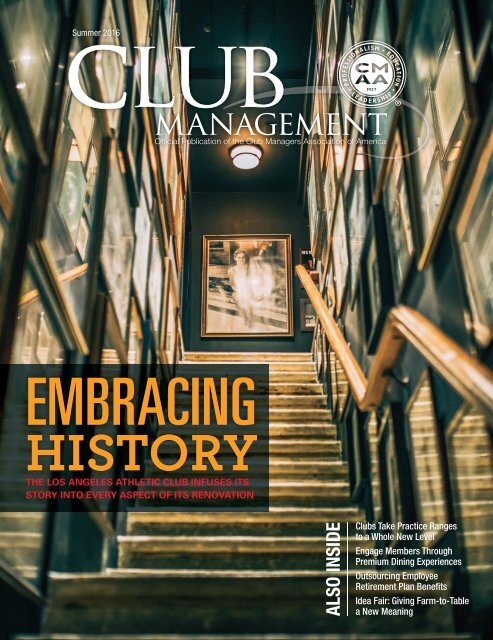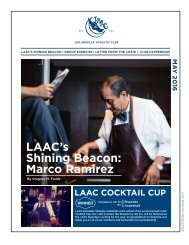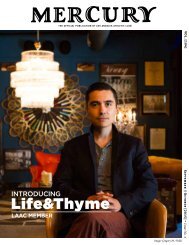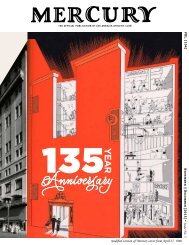Past Perfect: How LAAC Reinvented Itself for the Future
LA Athletic Club's recent innovation was bold, imaginative and purposely designed to attract a new class of patron: millennials.
LA Athletic Club's recent innovation was bold, imaginative and purposely designed to attract a new class of patron: millennials.
You also want an ePaper? Increase the reach of your titles
YUMPU automatically turns print PDFs into web optimized ePapers that Google loves.
Summer 2016<br />
EMBRACING<br />
HISTORY<br />
THE LOS ANGELES ATHLETIC CLUB INFUSES ITS<br />
STORY INTO EVERY ASPECT OF ITS RENOVATION<br />
ALSO INSIDE<br />
Clubs Take Practice Ranges<br />
to a Whole New Level<br />
Engage Members Through<br />
Premium Dining Experiences<br />
Outsourcing Employee<br />
Retirement Plan Benefits<br />
Idea Fair: Giving Farm-to-Table<br />
a New Meaning
Summer 2016<br />
Table of Contents<br />
Photo courtesy of <strong>the</strong> Metropolitan Club, DC<br />
Features<br />
16<br />
Core competency: Facilities Management<br />
Embracing History<br />
The Los Angeles Athletic Club infuses<br />
its story into every aspect of its renovation<br />
28<br />
Photo courtesy of Antonio Diaz<br />
A staircase hidden behind a bookcase in <strong>the</strong> Los<br />
Angeles Athletic Club leads to <strong>the</strong> Blue Room, a<br />
space that harkens to its speakeasy days while giving<br />
modern Angelenos <strong>the</strong> amenities <strong>the</strong>y demand.<br />
That’s just one space <strong>the</strong> <strong>LAAC</strong> trans<strong>for</strong>med during a<br />
multiyear renovation that incorporates historic details<br />
throughout <strong>the</strong> club.<br />
16<br />
24<br />
Core competency: Golf, Sports, and Recreation Management<br />
Putting <strong>the</strong> ‘Fun’ in Fundamentals<br />
Clubs take practice ranges to a whole new level<br />
The practice range, it’s often said, is <strong>the</strong> loneliest place<br />
on a golf course. But it doesn’t have to be that way. In<br />
fact, practice ranges at many of today’s golf clubs are<br />
making practice (gulp) fun and productive.<br />
In Every Issue<br />
4 President’s Message<br />
6 Member News<br />
15 Profiles in Excellence<br />
34 ClubSolutions SM<br />
37 Advertisers’ Index<br />
38 Idea Fair<br />
28<br />
Core competency: Food and Beverage Management<br />
Raising <strong>the</strong> Bar<br />
Clubs engage members through<br />
premium dining experiences<br />
Gone are <strong>the</strong> days when <strong>the</strong> pinnacle of club dining was<br />
prime rib and roast turkey, silver chafing dishes, and<br />
waiters in tuxedos. Today, members and guests dining<br />
at a club want engagement with an educated waitstaff,<br />
transparency in product origin, and a variety of choices<br />
to share and discuss.<br />
Articles in Club Management magazine have familiar colored icons<br />
that will enable you to use <strong>the</strong> magazine in <strong>the</strong> course of your workday.<br />
A green Pre-Certification triangle<br />
is designed <strong>for</strong> managers who<br />
have been in <strong>the</strong> industry <strong>for</strong> fewer than<br />
seven years.<br />
An orange Post-Certification square<br />
is designed <strong>for</strong> manag ers who have<br />
been in <strong>the</strong> industry <strong>for</strong> more than seven<br />
years. Some of <strong>the</strong>se managers have<br />
already obtained <strong>the</strong>ir Certified Club<br />
Manager (CCM) designation, are<br />
competent in all 10 management<br />
competencies, and have completed a<br />
series of education programs.<br />
A blue Executive circle speaks<br />
directly to <strong>the</strong> high est-ranking<br />
managers within <strong>the</strong> industry, many of<br />
whom have more than 15 years of club<br />
industry experience.<br />
A purple All diamond suggests<br />
content that will be of interest to a<br />
wide cross-section of CMAA members.<br />
ALL<br />
Summer 2016 3
Facilities Management<br />
EMBRACING THE<br />
PAST<br />
The Blue Room uses vintage photographs, athletic equipment and<br />
o<strong>the</strong>r memorabilia to create a connection to <strong>the</strong> club’s history.<br />
Photo courtesy of Antonio Diaz
CONNECTING TO THE<br />
FUTURE<br />
The Los Angeles Athletic Club infuses its history<br />
into a renovation designed to reach millennials<br />
By Gregory M. Fields
Facilities Management<br />
When <strong>the</strong> Los Angeles<br />
Athletic Club<br />
(<strong>LAAC</strong>) began <strong>the</strong><br />
most expansive renovation in <strong>the</strong> club’s<br />
history in 2014, <strong>the</strong> ambition of its leadership<br />
team wasn’t limited to spit-polishing<br />
<strong>the</strong> 125,000 square feet of its vaunted 1912<br />
Beaux Arts building. Instead, <strong>the</strong> caretakers<br />
of <strong>the</strong> city’s oldest and most storied social/<br />
athletic institution carved out a thoughtful<br />
and bold renovation plan that speaks to <strong>the</strong><br />
way today’s club members live, while celebrating<br />
its place in <strong>the</strong> city’s history.<br />
To do that, <strong>LAAC</strong>’s leadership undertook<br />
a wholesale reimagination of <strong>the</strong>ir target<br />
market, and <strong>the</strong>n leveraged design assets to<br />
attract a new kind of club member. Be<strong>for</strong>e<br />
<strong>the</strong> first wall was painted or <strong>the</strong> first lea<strong>the</strong>r<br />
couch was bought, <strong>LAAC</strong> re-evaluated its<br />
marketing strategy. The club’s staple clientele—Brooks<br />
Bro<strong>the</strong>rs-clad financial district<br />
professionals—were aging out. Taking<br />
<strong>the</strong>ir place were digital entrepreneurs, loft<br />
dwellers, and adventurous restaurateurs,<br />
who were flooding<br />
into <strong>the</strong> cavernous,<br />
abandoned spaces<br />
of downtown and<br />
sparking an epicurean<br />
revolution.<br />
And what a revolution<br />
it is. According<br />
to a recent Los<br />
Angeles Times article,<br />
78 tech-oriented firms<br />
now have offices in downtown L.A.; GQ<br />
magazine has called <strong>the</strong> area “America’s<br />
Next Great City.” Successful, stylish millennials<br />
have lifestyle money to spend (average<br />
income: $100,000), and <strong>the</strong> club is centrally<br />
located to <strong>the</strong> veritable explosion of lofts,<br />
bars, shops, and cutting-edge restaurants.<br />
<strong>LAAC</strong>’s holistic experience—an all-inone<br />
location to work, work out, imbibe,<br />
and dine—was already <strong>the</strong> ideal antidote to<br />
L.A.’s traditional carbon-consuming culture.<br />
Pair that with a young, entrepreneurial<br />
class eschewing <strong>the</strong> car-centric suburbs<br />
Top: Both sophisticated and casual, <strong>the</strong> Blue Room has become a favorite spot <strong>for</strong><br />
members. With several com<strong>for</strong>table seating areas, it’s perfect <strong>for</strong> long conversations.<br />
Bottom: Prior to <strong>the</strong> renovation, <strong>the</strong> Blue Room was an underutilized<br />
banquet room.<br />
Photo courtesy of Cory Hathaway<br />
<strong>for</strong> a walkable urban experience in a place<br />
with a strong sense of history, and you get<br />
<strong>the</strong> perfect membership match.<br />
But identifying a club’s prospective<br />
clientele and understanding what <strong>the</strong>y want<br />
are two entirely different skill sets. What<br />
was this new, serial-entrepreneurial class<br />
seeking <strong>for</strong> its ideal club experience? The<br />
answer turned out to be something very<br />
familiar to Angelenos.<br />
DESIGNING FOR THE DESIRED MEMBER<br />
Given that <strong>the</strong> club once counted silver-screen<br />
moguls Charlie Chaplin (who lived at <strong>LAAC</strong><br />
Photo courtesy of Antonio Diaz<br />
18 CLUB MANAGEMENT
Facilities Management<br />
during his <strong>for</strong>mative years), Walt Disney,<br />
and Mack Sennett among its membership, it<br />
seems logical that management employed an<br />
element of screenwriting technique to steer its<br />
rebranding ef<strong>for</strong>ts. <strong>LAAC</strong>’s renovation team<br />
created a character to personify <strong>the</strong> clientele<br />
<strong>the</strong>y hoped to reach. They gave him a job;<br />
<strong>the</strong>y knew where he lived.<br />
“We saw him as a serial tech entrepreneur<br />
who lived in <strong>the</strong> Eastern Columbia Building<br />
[a 1930 Art Deco landmark],” says <strong>LAAC</strong><br />
Assistant General Manager Cory Hathaway.<br />
“From <strong>the</strong>re, we built out 10 action items that<br />
would most appeal to this person.”<br />
These items would eventually become<br />
distilled into every management renovation<br />
decision, from <strong>the</strong> type of beer featured at<br />
<strong>the</strong> club’s restaurant/bar to <strong>the</strong> colors and<br />
surfaces <strong>for</strong> The Blue Room, a centerpiece<br />
of <strong>the</strong> <strong>LAAC</strong>’s revitalization. A whimsical<br />
speakeasy reimagined by British designer<br />
Timothy Oulton, <strong>the</strong> Blue Room’s only<br />
access is through a card-keyed door embedded<br />
in a faux book case. If you’re sharpeyed<br />
enough to find <strong>the</strong> door, a “hidden”<br />
Prohibition-era staircase lined with vintage<br />
photos leads up to <strong>the</strong> room itself. With<br />
every step, members literally walk through<br />
<strong>the</strong> club’s history.<br />
“We thought <strong>the</strong> ‘secret’ staircase added<br />
an air of intrigue that would appeal to our<br />
character,” Hathaway says.<br />
COLLABORATING WITH MEMBERS<br />
The <strong>LAAC</strong> membership is a highly vested<br />
community with a longstanding tradition<br />
of participation in club improvements (one<br />
club president famously sold off his living<br />
room furnishings to help pay <strong>the</strong> <strong>LAAC</strong>’s<br />
bills during <strong>the</strong> Great Depression). So<br />
naturally, members were involved in <strong>the</strong><br />
planning process.<br />
To introduce <strong>the</strong> renovations, members<br />
were invited into a specially created Discovery<br />
Center. This showroom featured design<br />
boards <strong>for</strong> <strong>the</strong> project, renderings of <strong>the</strong> new<br />
spaces, locker samples, and a timeline <strong>for</strong> <strong>the</strong><br />
construction of each area. (The 18-month<br />
project was broken into three, six-month<br />
segments, which allowed continuous access to<br />
<strong>the</strong> existing locker rooms.) <strong>LAAC</strong> members<br />
were encouraged to leave <strong>the</strong>ir own suggestions<br />
<strong>for</strong> management to review.<br />
Club leadership also took advantage of<br />
<strong>the</strong> expertise of members in <strong>the</strong> project.<br />
While <strong>LAAC</strong> has never had a standing<br />
design committee, it keeps a select group of<br />
member creatives in a shallow orbit. This<br />
way, <strong>the</strong>ir expertise can be tapped <strong>for</strong> idea<br />
generation from time to time. Members<br />
with professional skills in interior design,<br />
cocktail consulting, and photography all<br />
contributed to <strong>LAAC</strong>’s renovation.<br />
PURPOSEFUL REPURPOSING<br />
The club’s heritage, which o<strong>the</strong>rs might<br />
have thoughtlessly pushed aside, was<br />
wholeheartedly embraced by management<br />
as a competitive advantage. This new breed<br />
of tastemakers and tech cognoscenti were<br />
living and playing in ironclad, carvedstone<br />
spaces from <strong>the</strong> trolley-car era. With<br />
its current 12-story location opening <strong>the</strong><br />
same year as <strong>the</strong> launch of <strong>the</strong> Titanic, <strong>the</strong><br />
Photo courtesy of Cory Hathaway<br />
Top: Members now have a crisp and modern place<br />
to shower after a day at <strong>the</strong> club. Bottom: The shower<br />
stalls prior to <strong>the</strong> renovation were functional, but felt<br />
and looked institutional.<br />
Photo courtesy of Josh Telles<br />
20 CLUB MANAGEMENT
Facilities Management<br />
Right: Prior to <strong>the</strong> renovations, <strong>the</strong> locker room lounge had a dated, mismatched look.<br />
Above: The new design of <strong>the</strong> lounge makes members never want to leave.<br />
club’s rich architectural environs evoke an<br />
au<strong>the</strong>nticity that could not be fabricated.<br />
But what to toss and what to keep? The<br />
management team had to tread lightly.<br />
Retrofitting an historic space with newer,<br />
generic assets could undermine <strong>the</strong> club’s<br />
uniquely appealing character. Management<br />
sought to pinpoint that elusive dividing line<br />
between old-school and old hat.<br />
“We told our designers we didn’t want 100<br />
percent historic or 100 percent modern,”<br />
Hathaway says. “We wanted a balance.”<br />
The club’s streamlined, monochrome<br />
logo was replaced with <strong>the</strong> 100-year-old<br />
hand-drawn one. Old club photos, signs,<br />
trophies, and o<strong>the</strong>r memorabilia were<br />
pulled out of storage, reframed, and added<br />
to newly renovated spaces.<br />
The Blue Room is a perfect representation<br />
of this eccentric eclecticism. Charlie Chaplin’s<br />
<strong>LAAC</strong>-inspired short The Cure runs<br />
in a loop on one of<br />
<strong>the</strong> room’s walls.<br />
Vintage fencing<br />
masks fade into <strong>the</strong><br />
Blue Room walls like partially obscured<br />
samurais. Hardcover books spool around<br />
a support pillar, and whimsical wall sculptures<br />
are arranged out of wooden tennis<br />
racks and violins—a nod to <strong>the</strong> club’s history<br />
as a center <strong>for</strong> sports and culture.<br />
“We thought it would be interesting to<br />
take ordinary objects and repurpose <strong>the</strong>m<br />
in an unexpected way,” Hathaway says.<br />
This cohabitation of <strong>the</strong> old and <strong>the</strong><br />
new results in design that is simultaneously<br />
striking <strong>for</strong> its contrasting elements,<br />
but still com<strong>for</strong>table and familiar—like<br />
a dreamy, sepia-toned photo. As<br />
members connect with each o<strong>the</strong>r in this<br />
environment, <strong>the</strong>y also connect to <strong>the</strong><br />
club’s legacy.<br />
Photo courtesy of Cory Hathaway<br />
CRAVING CONNECTION<br />
The leadership mused that its model entrepreneur/loft<br />
dweller is likely deeply ensconced<br />
in online networking and a natural<br />
collaborator. Even traditional companies<br />
are taking a wrecking ball to <strong>the</strong>ir cubicle<br />
cultures in favor of open worktables.<br />
Similarly, <strong>the</strong> migration to denser urban<br />
environs naturally requires bumping up<br />
against neighbors instead of building fences<br />
to keep <strong>the</strong>m out. <strong>LAAC</strong>’s top-to-bottom<br />
revitalization of <strong>the</strong> men and women’s locker/lounge<br />
spaces by Los Angeles-based SRK<br />
Architects embodies this epic shift toward<br />
making all aspects of life more social.<br />
“We could have added more lockers, but<br />
we really wanted to cultivate a more social,<br />
Photo courtesy of Josh Telles<br />
22 CLUB MANAGEMENT
elaxing environment,”<br />
Hathaway says.<br />
The hub of <strong>the</strong> space<br />
is a <strong>for</strong>um-style lounge<br />
area. With its open design,<br />
living room-ready couches,<br />
and big-screen television,<br />
<strong>the</strong> area invites social<br />
relaxation.<br />
Every design point is<br />
meant to encourage interaction.<br />
Even <strong>the</strong> shoeshine<br />
station offers dual, raised<br />
chairs so colleagues can<br />
engage in a tête-à-tête<br />
about <strong>the</strong>ir next digital<br />
start-up. NBA-style, woodgrain<br />
lockers replaced <strong>the</strong><br />
club’s aging metal ones<br />
and provide an aura of<br />
premium com<strong>for</strong>t without<br />
<strong>the</strong> stuffiness. Bookshelves<br />
feature club memorabilia,<br />
including vintage sports<br />
trophies and plaques.<br />
Perhaps <strong>the</strong> most storied<br />
feature of <strong>the</strong> <strong>LAAC</strong> is <strong>the</strong><br />
sixth-floor pool, sparkling<br />
beneath skylights and a<br />
vintage chandelier. <strong>LAAC</strong><br />
was <strong>the</strong> first structure in<br />
Sou<strong>the</strong>rn Cali<strong>for</strong>nia to<br />
have a swimming pool<br />
above ground level, and<br />
<strong>the</strong> pool once served as a<br />
training ground <strong>for</strong> Olympic<br />
athletes.<br />
<strong>LAAC</strong>’s renovation<br />
brings back <strong>the</strong> Plunge<br />
Cafe, a poolside dining<br />
area where members in<br />
<strong>the</strong> 1920s and 1930s enjoyed<br />
poolside brunches,<br />
fashion shows, and New<br />
Year’s celebrations—just<br />
<strong>the</strong> kind of casual social<br />
interaction that today’s<br />
tech-immersed millennials<br />
crave.<br />
Greg Fields is a founder of<br />
<strong>the</strong> Occupy Digital Agency.<br />
He lives in downtown L.A.’s<br />
Arts District.<br />
Summer 2016 23





